Welcoming a 4 month old cat into your home is like getting a burst of energy and curiosity. Your kitten is now a lively young cat, eager to explore the world. At this time, they are changing fast, growing in personality and skills.
Your 4 month old cat is full of energy and playfulness. They are becoming more independent but still love your company. These early months are key for building good habits, understanding their personality, and forming a lifelong bond.
Every kitten is different, but knowing what to expect at 4 months can help you care for them well. This guide covers everything from their diet to their behavior. It’s all about helping you support your growing cat during this exciting time.
Table of Contents
Physical Development of a 4 Month Old Cat
Understanding your kitten’s growth stages is key when caring for a young cat. At 4 months, your kitten is in a thrilling phase. They quickly grow from a tiny baby to a more independent cat.

Your kitten’s body is changing a lot during this time. They move from being a dependent baby to a young cat that can take care of itself. They grow a lot every week.
Growth Milestones
At 4 months, kittens hit several important physical milestones:
- Eye color starts to settle from gray/blue to its permanent color
- Baby teeth keep growing
- Coat gets denser and more adult-like
- Muscles and coordination get much better
Weight Range
| Breed Size | Average Weight Range |
|---|---|
| Small Breeds | 3-4 pounds |
| Medium Breeds | 4-5 pounds |
| Large Breeds | 5-6 pounds |
Grooming Needs
Setting up good grooming routines is important for a young cat. At 4 months, your kitten’s coat gets more complex. It needs regular brushing to avoid matting and keep the skin healthy.
“Grooming is not just about appearance, but a critical aspect of your kitten’s overall health and bonding experience.”
Regular grooming lets you check your cat’s health. It helps spot any unusual bumps, skin changes, or health problems early.
Behavioral Changes at 4 Months
Your 4-month-old kitten is entering an exciting stage of development. This stage is marked by significant kitten behavior changes. They will show more energy, start to hunt, and learn social skills that shape their personality.
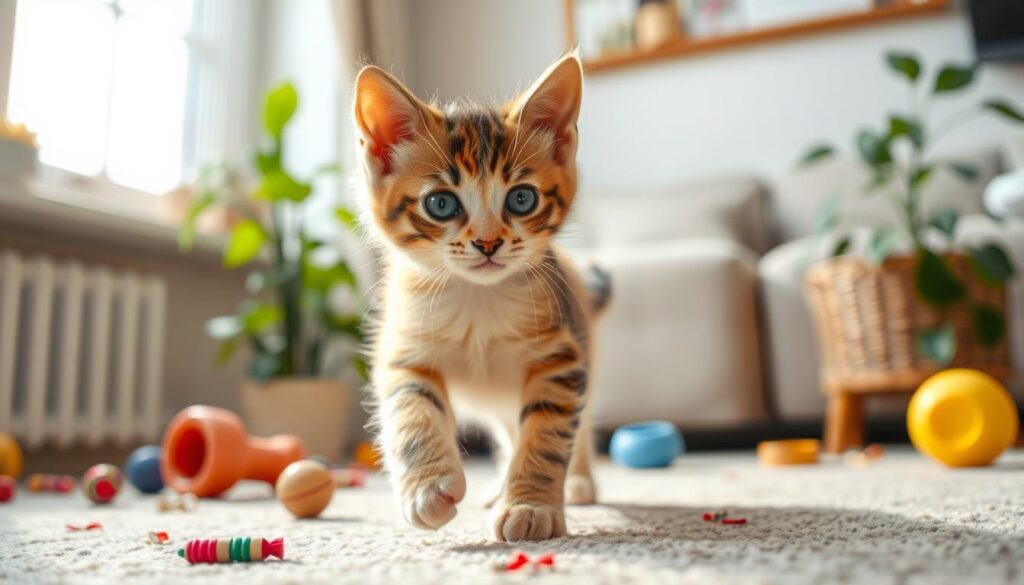
Increased Energy Levels
At this age, your kitten’s energy levels skyrocket. Play aggression is common, with most kittens playing 3-5 times a day. About 50% of kittens show “choosing violence” during play.
- Expect frequent bursts of high-energy activity
- Understand that play is crucial for physical and mental development
- Provide interactive toys to channel their energy
Hunting Instincts
Understanding your kitten’s natural hunting behaviors is key. Cats show their hunting instincts in several ways:
| Hunting Behavior | Description |
|---|---|
| Stalking | Quiet, low-to-ground movement |
| Chasing | Rapid pursuit of moving objects |
| Grabbing | Simulated prey capture |
Socialization Skills
Socialization is crucial during this phase. Research shows that 70% of cats do better when socialized early. They tend to prefer companionship and interaction.
Consistent routine and positive interactions are key to developing a well-adjusted cat.
- Introduce your kitten to various people and environments
- Use positive reinforcement during social interactions
- Avoid sudden changes that might cause stress
Nutrition Guidelines for Your 4 Month Old Cat
Proper nutrition is key for your kitten’s growth. At 4 months, they need a diet that supports their fast growth and energy. This diet should be carefully planned.
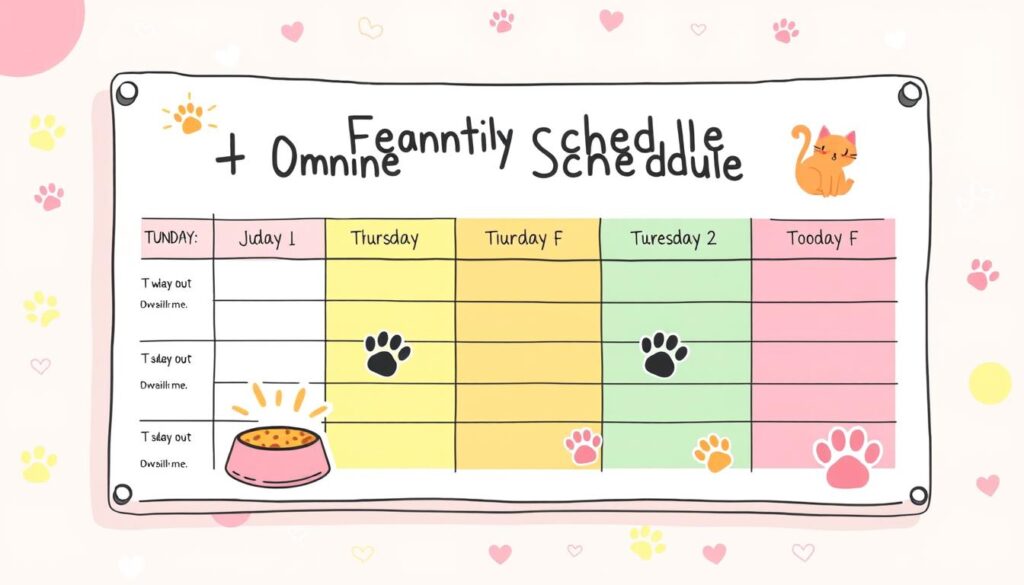
Ideal Diet Composition
Your kitten’s diet should have high-quality protein. The cat growth chart shows kittens need more nutrients than adult cats. Look for foods that meet AAFCO standards for complete nutrition.
- First ingredient should be meat (chicken, fish, or turkey)
- Include essential nutrients like omega-3 fatty acids
- Avoid foods with excessive carbohydrates
Kitten Feeding Schedule
It’s important to have a regular feeding schedule for your kitten. Young cats need 3-4 meals a day to keep up with their fast metabolism.
| Age | Meals per Day | Calories Needed |
|---|---|---|
| 4 Months | 3-4 | 60-80 calories per pound |
Treats and Snacks
Treats should not make up more than 10% of your kitten’s daily calories. Choose protein-rich, vet-approved treats that go well with their main food.
“Nutrition is the foundation of your kitten’s health and future well-being.” – Veterinary Nutrition Expert
Wet cat food has about 70% more water than dry food, which helps with hydration. Always talk to your vet to make the best nutrition plan for your kitten.
Vaccination Schedule for Kittens
Keeping your young cat healthy starts with a good vaccination plan. Your 4-month-old kitten needs specific shots to fight off serious diseases. This is a key part of their kitten vaccination timeline.
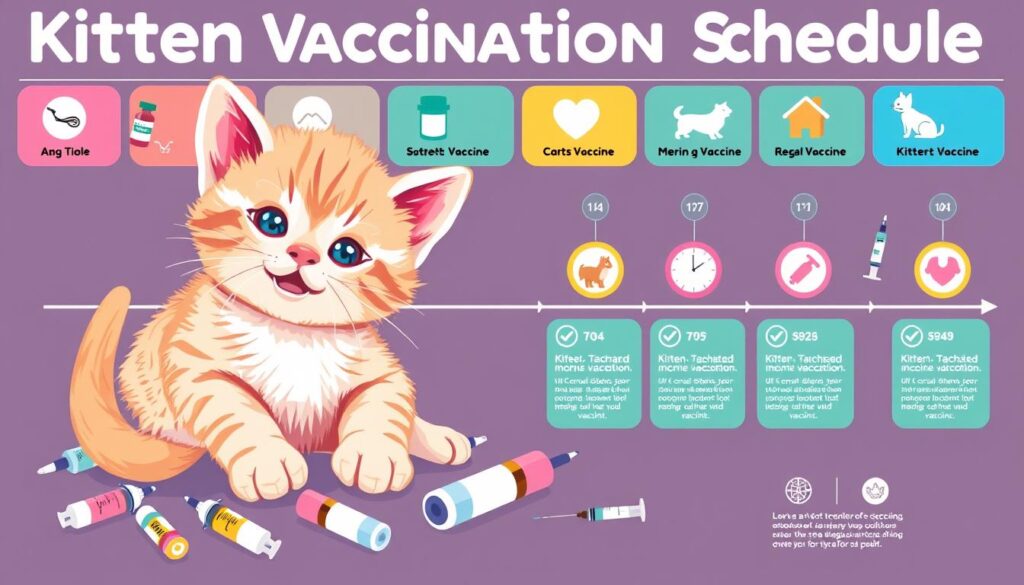
Vets suggest a structured plan for your kitten’s health. This includes core and optional vaccines to keep your kitten safe.
Core Vaccinations Every Kitten Needs
Core vaccines protect your kitten from deadly diseases. The main vaccines your kitten needs are:
- FVRCP (Feline Viral Rhinotracheitis, Calicivirus, Panleukopenia)
- Rabies vaccination
- Feline Leukemia (for outdoor cats)
Recommended Vaccination Timeline
| Age | Vaccination | Purpose |
|---|---|---|
| 6-8 weeks | First FVRCP | Initial immune protection |
| 12 weeks | Rabies vaccine | Legal requirement in most states |
| 16 weeks | Booster vaccinations | Complete initial immunity |
Optional Vaccines to Consider
Based on your kitten’s life, extra vaccines might be suggested:
- Bordetella (for cats in multi-pet environments)
- Chlamydia vaccination
- FIV vaccine (for high-risk outdoor cats)
“No vaccine offers 100% protection, but they significantly reduce illness risks for your kitten.”
Importance of Regular Vet Visits
Annual vet visits are key for your kitten’s health. These visits help vets:
- Check your kitten’s growth and health
- Update vaccination records
- Look for health problems
- Give health advice tailored to your kitten
Pro tip: Keep a detailed record of your kitten’s vaccination history for future reference and healthcare planning.
Litter Box Training Essentials
Caring for a young cat means learning how to train them to use a litter box. This is a big step in their development. By four months, your kitten should be going to the bathroom in the right place. Knowing how to train them well is important for a stress-free experience.
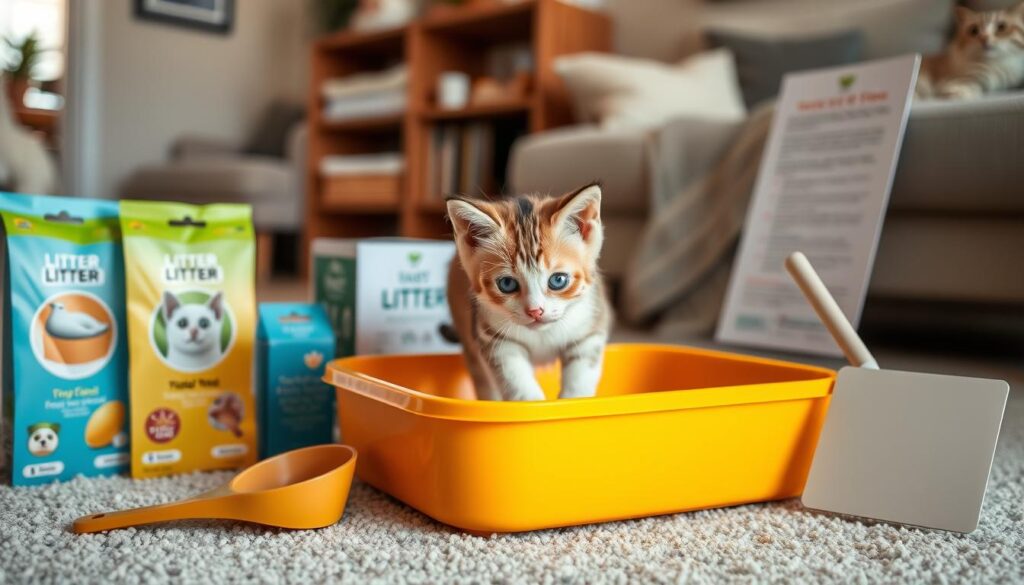
Training your kitten to use the litter box needs focus on a few key things. Their comfort and understanding are key to good habits.
Choosing the Right Litter
Choosing the right litter is very important. Here are some things to think about:
- Use unscented litter with fine particles
- Fill the box with 2-3 inches of litter
- Choose clumping litters for easier maintenance
- Opt for low-dust formulas to protect respiratory health
Effective Training Tips
Using the right training methods can help your kitten learn good habits:
- Place the litter box in a quiet, accessible location
- Use positive reinforcement with immediate treats
- Supervise your kitten during initial training
- Maintain consistent cleaning schedules
Common Mistakes to Avoid
Stay away from common mistakes to avoid litter box problems:
| Mistake | Solution |
|---|---|
| Infrequent cleaning | Scoop daily, deep clean weekly |
| Wrong litter box size | Use box 1½ times larger than kitten |
| Insufficient number of boxes | Have one box per cat, plus one extra |
“Patience and consistency are key in litter box training your young cat.” – Veterinary Experts
Remember, every kitten is different. Some might need more time and patience. Stay positive and supportive during training.
Playtime Activities for Kittens
Playtime is key for your 4-month-old kitten’s growth. It helps with their physical and mental health. It’s about making play fun and engaging, matching their natural instincts and energy.
Interactive Toy Selection
Choosing the right toys is important. It turns playtime into learning moments. Here are some top picks:
- Teaser wands for hunting simulation
- Puzzle toys that challenge mental skills
- Electronic interactive toys
- Feather toys that mimic prey movement
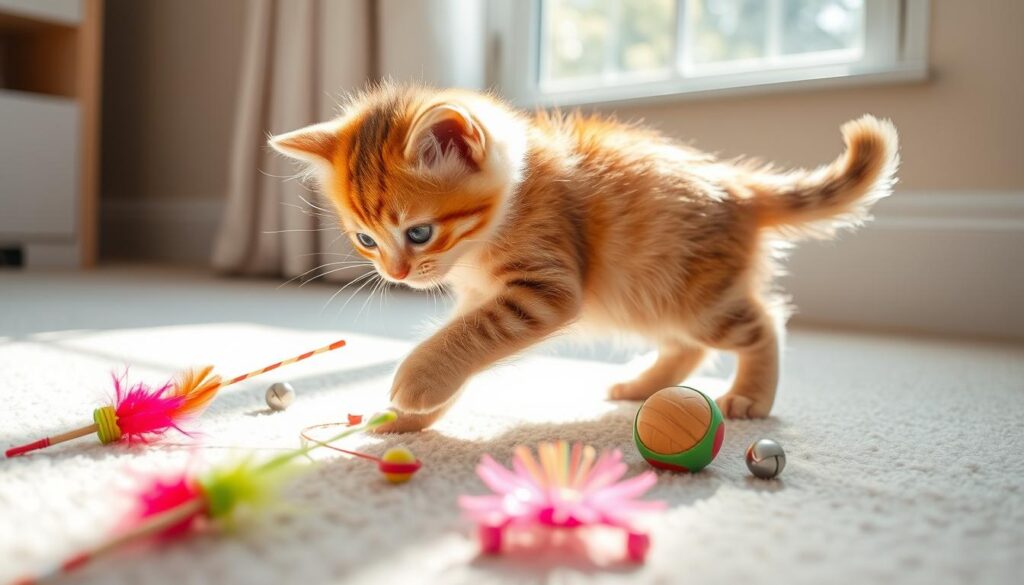
Safe Play Environments
Make a special play area for your kitten. It should be safe and fun. Add cat trees and climbing spots to keep them curious.
| Play Environment Element | Benefits |
|---|---|
| Cat Tree | Vertical exploration, exercise, observation point |
| Cardboard Boxes | Free entertainment, hiding spots, texture exploration |
| Window Perch | Visual stimulation, mental engagement |
Encouraging Playful Interactions
Keep your kitten active with different activities. Clicker training is great for bonding and learning tricks. It makes playtime fun.
Pro Tip: Always supervise play and rotate toys to maintain your kitten’s interest and prevent boredom.
Here are some play tips:
- Short, frequent play sessions
- Varied toy selections
- Mimicking hunting behaviors
- Rewarding interactive play
Regular playtime is vital. It helps your kitten grow physically and strengthens your bond.
Understanding Your Kitten’s Personality
As your kitten grows, their personality starts to show. By four months, they have their own way of acting and feeling. This shows who they are and how they feel.
Signs of Affection
Kittens show love in many ways as they grow. Look for these signs of affection:
- Soft purring when you pet them
- Kneading with their paws
- Rubbing against your legs
- Bringing you “gifts” like toys
- Seeking close physical contact
Indicators of Stress
It’s important to know when your kitten is stressed. Look out for these signs:
- Excessive hiding
- Sudden aggression
- Changes in eating habits
- Excessive grooming
- Frequent vocalization
Recognizing Fearful Behaviors
Kittens can show fear in different ways. Watch for these signs:
| Behavior | Potential Fear Indication |
|---|---|
| Flattened ears | High anxiety or threat perception |
| Tail tucked under body | Feeling vulnerable or scared |
| Hissing or growling | Defensive response to perceived danger |
“Understanding your kitten’s personality is a journey of patience and observation.” – Veterinary Behaviorist
Remember, each kitten is unique. Consistent love, gentle interaction, and understanding will help build a strong bond with your furry companion.
Socializing Your 4 Month Old Cat
Caring for a young cat is more than just food and shelter. The first few months are key for a happy, well-adjusted cat. Socialization shapes their future behavior and mood.

It takes patience and smart strategies for socialization. The Anti-Cruelty Society says start early, as the window is short.
Introducing New People
Here’s how to introduce your kitten to new people:
- Start with calm, quiet interactions
- Let the kitten approach when ready
- Use treats for positive vibes
- Keep first meetings short, 10-15 minutes
Meeting Other Pets
Introducing your kitten to other pets needs careful steps. Studies show 70% of cat introductions succeed with slow exposure.
| Introduction Method | Success Rate |
|---|---|
| Slow Reintroduction | 70% |
| Clicker Training | 65% |
| Pheromone Usage | 75% |
Importance of Positive Experiences
Positive socialization experiences are key to your kitten’s future. 70-80% of cats love “cat parties” with toys and treats.
“Early socialization is the key to raising a confident and well-adjusted cat.” – Feline Behavior Experts
Don’t wait too long to socialize your kitten. Before 6 months, it gets harder. Spend time now for a friendly, social cat for years.
Health Care Basics for Young Cats
Caring for a young cat means knowing how to keep them healthy. Your 4-month-old kitten needs regular medical care. This helps them stay well and avoid health problems later on.
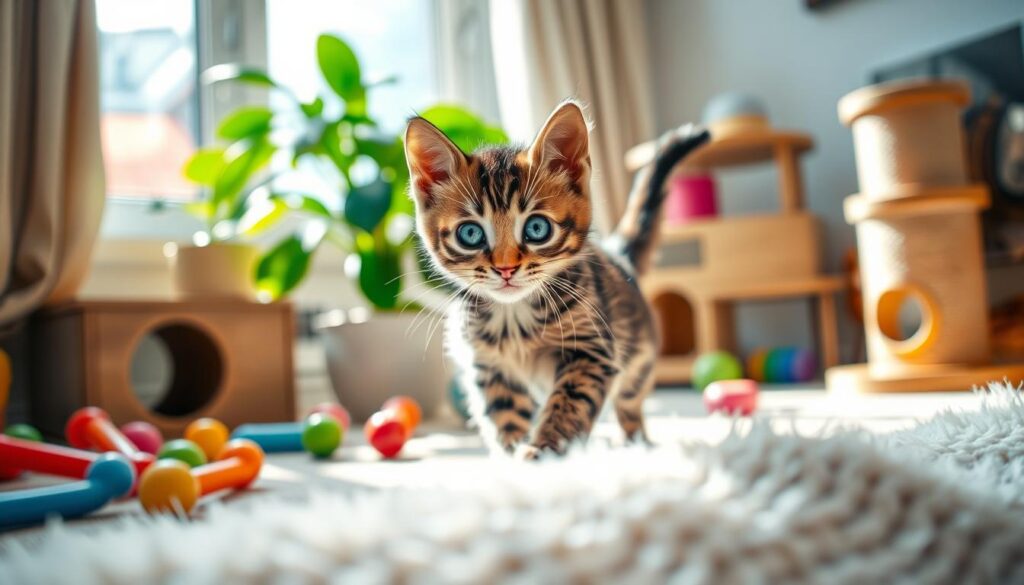
It’s important to manage your kitten’s health proactively. Tips for young cat health include regular vet visits and preventive care.
Regular Check-Ups: Establishing a Health Baseline
Vets say to take your kitten to the vet every 3-4 weeks when they’re young. These visits are crucial for:
- Tracking their growth
- Keeping up with vaccinations
- Checking their physical development
- Spotting any health issues early
Dental Care Essentials
Good oral health is key to avoiding future problems. Start dental care early by:
- Using a kitten-specific toothbrush
- Teaching gentle brushing habits
- Choosing the right dental treats
Common Health Considerations
Knowing about common health issues helps you catch problems early. Focus on:
| Health Area | Potential Concerns | Prevention Strategy |
|---|---|---|
| Parasites | Fleas, Ticks | Year-round preventive treatments |
| Nutritional | Vitamin Deficiencies | AAFCO-compliant diet |
| Genetic | Breed-specific conditions | Regular genetic screenings |
“Prevention is always better than cure when caring for a young cat.” – Veterinary Experts
Remember, early intervention is crucial for your kitten’s health. Be vigilant and keep in touch with your vet regularly.
Creating a Safe Home Environment
Caring for a young cat means getting your home ready. Your 4-month-old kitten is starting to explore and grow fast. It’s important to make your home safe to support their development and avoid accidents.
Cat-Proofing Your Space
To keep your home safe from your kitten’s curiosity, follow these steps:
- Remove toxic plants like lilies and azaleas
- Secure electrical cords and small objects
- Close toilet lids and keep chemicals locked away
- Block potential hiding spaces behind appliances
Safe Spaces for Rest
Kittens sleep a lot, up to 20 hours a day. It’s key to have cozy places for them to rest.
| Rest Area Type | Benefits |
|---|---|
| Cozy Cat Bed | Provides warmth and security |
| Elevated Perch | Allows observation and feeling of safety |
| Quiet Corner Hideaway | Offers retreat from overstimulation |
Importance of Scratching Posts
Scratching is natural for kittens. A good scratching post can:
- Protect your furniture
- Help maintain claw health
- Provide physical and mental stimulation
“A well-placed scratching post is like a gym membership for your kitten’s physical and emotional development.”

Tip: Place scratching posts near your kitten’s favorite resting spots to encourage natural use.
Choosing the Right Cat Food
Choosing the right food for your 4-month-old kitten is important. Their diet affects their growth, health, and overall well-being. It’s a key part of caring for a young cat.
Dry vs. Wet Food: Making the Right Choice
Understanding the difference between dry and wet food is crucial. Each type has different nutritional content:
- Dry Food: Contains 10-12% moisture
- Wet Food: Contains 75-78% moisture
High-Quality Ingredients Matter
Not all cat foods are the same. Look for foods that meet AAFCO standards. They should have specific nutritional profiles:
| Brand | Protein % | Fat % | Fiber % |
|---|---|---|---|
| Wellness Gravies Salmon | 51% | 22% | 14% |
| Merrick Chicken Recipe | 50.1% | 36.2% | 0.3% |
| Instinct Salmon Recipe | 48% | 18% | 9% |
Feeding Your Kitten Properly
For kittens aged 4 months, a consistent feeding schedule is key. Vets recommend:
- Feed 3-4 times daily
- Portion sizes based on body weight
- Monitor calorie intake (6-10% of body weight)
“Nutrition is the foundation of your kitten’s future health and development.” – Veterinary Nutrition Expert
Pro tip: Always consult your veterinarian to create a personalized nutrition plan that meets your kitten’s specific needs.
Signs of a Healthy 4 Month Old Cat
It’s important to know the signs of a healthy kitten. As your kitten grows, watching their development is key. Spotting health issues early helps them grow well.
Healthy Coat and Skin Indicators
A healthy 4-month-old cat shows clear signs in their coat and skin. Look for these signs of good health:
- Shiny, smooth fur without bald patches
- No excessive dandruff or dry skin
- Clean ears free from discharge
- Skin that appears elastic and hydrated
Active and Playful Behavior
Kittens should be full of energy and playful. A healthy 4-month-old cat will:
- Play regularly for 10-15 minutes
- Show curiosity about their surroundings
- Quickly recover after playing
- Enjoy interactive toys
Normal Eating Habits
Good nutrition is crucial for your kitten’s growth. Watch for these eating habits:
| Eating Habit | Healthy Range |
|---|---|
| Daily Food Intake | 30-50g dry food or 130-165g wet food |
| Feeding Frequency | 3-4 meals per day |
| Water Consumption | Regular, consistent drinking |
“A healthy kitten is an active, curious, and well-nourished companion.” – Veterinary Nutrition Experts
Every kitten is different. Regular vet visits are the best way to check their health.
Recognizing Illness in Your Kitten
Caring for a young cat means watching closely for health issues. Knowing the signs of illness is key to your kitten’s health.
Common Symptoms to Watch For
Young cat health tips stress the need to watch your kitten’s behavior and health. Look out for these warning signs:
- Sudden changes in appetite or water consumption
- Unusual lethargy or decreased activity
- Persistent vomiting or diarrhea
- Difficulty breathing
- Unexplained weight loss
When to Seek Veterinary Care
Some symptoms need quick vet care. Here’s a guide to help you check your kitten’s health:
| Symptom | Action Required |
|---|---|
| Body Temperature > 104°F | Emergency Veterinary Care |
| Persistent Fever (103-104°F) | Veterinary Consultation Within 24 Hours |
| Seizures or Disorientation | Immediate Veterinary Emergency |
“Early detection and prompt medical intervention can significantly improve your kitten’s health outcomes.” – Veterinary Experts
Remember, kittens under 4 months are especially at risk. Trust your instincts and get vet advice when something seems off.
Make sure to schedule regular vet visits. Keep in touch with your vet for the best care for your young cat.
The Importance of Spaying/Neutering
Spaying or neutering is a key health choice for young cats. It greatly benefits their long-term health and behavior.
Spaying and neutering do more than control population. They are vital for your kitten’s well-being, improving their life quality.
Health Benefits
Spaying/neutering has amazing health perks. Here are some:
- Reduces risk of mammary gland tumors by up to 90%
- Prevents life-threatening reproductive system diseases
- Extends your cat’s potential lifespan
Behavioral Benefits
Neutering changes your cat’s behavior. They often become:
- Less aggressive
- More calm and relaxed
- Less likely to spray or mark territory
Timing and Process
Vets usually suggest spaying/neutering at 4-6 months. The process is quick:
- Pre-surgical health screening
- Short anesthesia procedure
- Same-day recovery
“Spaying and neutering are investments in your cat’s health and happiness.”
Recovery is easy, with most cats back to normal in 10-14 days. Your vet will give detailed care instructions.
Introducing Your Kitten to a New Home
Bringing a new kitten home is an exciting adventure. It needs patience and careful planning. Creating a welcoming environment helps your kitten feel safe and comfortable.
It can take several weeks for a new kitten to adjust. Up to 70% of cats adapt well with careful introduction. Your approach greatly affects how quickly your kitten settles in.
First-Day Essentials
- Prepare a quiet, confined space for initial settling
- Set up essential resources like litter box, food, water, and a cozy bed
- Minimize loud noises and sudden movements
- Allow gentle, supervised exploration
Establishing Comfortable Routines
Kitten behavior changes a lot in the first days. Creating consistent daily schedules helps reduce stress and builds trust. Here are some strategies to build routines:
- Maintain regular feeding times
- Create predictable play sessions
- Establish a calm sleeping environment
- Use positive reinforcement techniques
Gradual Home Exploration
Cats are naturally curious, but kitten behavior changes need a measured approach. Start by introducing one room at a time. This lets your kitten get familiar with each space gradually.
“Patience is key when helping your kitten feel secure in their new home.” – Veterinary Behavior Experts
| Exploration Stage | Duration | Key Recommendations |
|---|---|---|
| Initial Confinement | 1-2 days | Single room, limited stimuli |
| Supervised Exploration | 3-7 days | Gradual access to additional rooms |
| Full Home Access | 1-2 weeks | Complete house exploration |
Pro tip: Use pheromone diffusers to help reduce stress during the introduction process. These can help approximately 60% of cats feel more comfortable in new environments.
Preparing for Future Training
Training your kitten is key to caring for a young cat. As your kitten grows, it’s important to teach good habits. This helps with behavior and bonding.
Cats are smart and like positive training. Starting early sets a strong base for future talks and actions.
Understanding Training Fundamentals
Good kitten training uses a few main strategies:
- Use positive reinforcement techniques
- Keep training sessions short and engaging
- Reward desired behaviors immediately
- Be patient and consistent
Effective Training Methods
There are many ways to train kittens, depending on their personality. Here’s a quick guide:
| Training Method | Best For | Technique |
|---|---|---|
| Clicker Training | Teaching specific commands | Use sound marker with treats |
| Reward-Based Training | Encouraging good behavior | Offer treats for desired actions |
| Interactive Play | Building trust and skills | Use toys to engage and teach |
Building a Strong Bond
Training is more than just teaching commands. It’s about making a strong connection. Spend quality time with your kitten, showing love and patience during each training session.
“Training a kitten is an investment in your future relationship. Approach it with love and understanding.” – Feline Behavior Expert
Every kitten is different. Tailor your training to fit your cat’s personality and learning style. With love and effort, you’ll build a lifelong bond.
Resources for New Cat Owners
Starting your journey with a young cat? Finding good resources is key. The world of kitten care can feel overwhelming. But, there are many tools and communities ready to help.
You’ll find expert vet advice and online support groups. They offer a wealth of information to care for your cat.
Recommended Books
Looking for books on young cat care? Check out “The Cat Owner’s Home Veterinary Handbook” by Debra M. Eldredge or “Complete Kitten Care” by Amy Shojai. These guides dive deep into nutrition, development, and health for your kitten.
For quick vet advice, try digital resources like PangoVet. They offer online consultations.
Online Communities
Digital platforms are great for new cat owners. Sites like Reddit’s r/cats and Facebook groups for kitten care are full of advice. You’ll find real-world tips, personal stories, and emotional support.
Just remember to check facts with vets and trusted sources.
Local Pet Services
Your area probably has many kitten care resources. Look for vet clinics focused on cats, pet stores with knowledgeable staff, and animal shelters with workshops. You might find microchipping, vaccination clinics, and training resources.

